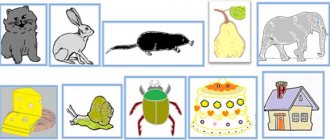Say it kindly
The game teaches preschoolers to form the diminutive form of nouns. The player names the fish shown in the picture, then transforms the name:
- pike perch - pike perch;
- pike - pike;
- crucian carp - crucian carp;
- bream - bream;
- stingray - stingray;
- shark - little shark;
- burbot - burbot;
- catfish - catfish.
Fourth wheel
This is another interesting game for older preschoolers. The teacher lays out 4 cards in a row, and the children try to understand which image is superfluous and give reasons for the choice.
Here are examples for the game:
- herring, silver carp, sailfish, mackerel;
- shark, moray eel, clown fish, piranha;
- trout, zebrafish, angelfish, guppies;
- tuna, halibut, flounder, swordtail;
- pike, stingray, carp, crucian carp.
Name the big fish
The teacher explains that an object that seems huge is named using the appropriate suffix. Next he shows the pupils pictures. Children try to transform the names of the fish on display. For example:
- pike - pike;
- burbot - burbot;
- pike perch - judge;
- sturgeon - sturgeon;
- shark - shark;
- slope - slope.
Description
Fish are symmetrical animals with a streamlined body shape. Bottom-dwelling, camouflaged fish that lead a sedentary lifestyle have a non-streamlined body shape.
Fish are perfectly adapted to life in water, as evidenced by the features of their external structure:
- thin skin with mucous glands is covered with scales;
- fins (caudal, dorsal, pectoral, ventral, anal), located throughout the body, help to swim;
- the head is not separated from the body, and the body is not separated from the tail;
- there are well developed gills.
Rice.
1. External structure. The development of fish classes dates back to the Devonian period (approximately 300 million years ago). All fish descended from a common ancestor - an ancient armored fish, the skeleton of which consisted of cartilage, but the jaws had a bony structure.
Arranging fish pictures into groups
There are a lot of cards included, you don't have to use them all. Choose pictures that are appropriate for the child's age. To make it more interesting for preschoolers to get acquainted with underwater inhabitants, and to expand their understanding of fish species, you can offer exciting games. One of these games is the distribution of cards into groups: sea fish, river fish, predatory fish, aquarium fish. Preschoolers play this game with great enthusiasm.
Pictures of sea fish with names for children
The pictures introduce preschoolers to such interesting sea inhabitants as:
- shark;
- stingray;
- flounder;
- clown fish;
- halibut;
- sea Horse;
- sawfish;
- mackerel;
- angel fish;
- hammerhead fish;
- tuna;
- sea ruff;
- sea bass;
- fugu fish;
- sailboat;
- herring;
- flying fish.
Names of river fish for children
Preschoolers should know river fish even better than sea fish, because these representatives of underwater fauna live close to us, in rivers and lakes, and are caught by fishermen. This:
- crucian carp;
- pike;
- river ruff;
- river perch;
- gudgeon;
- bream;
- zander;
- catfish;
- sturgeon;
- silver carp;
- carp;
- trout.
Predatory fish
This category includes freshwater and marine life. That is, children need to be explained that predators are found in the seas, rivers and lakes. These are fish such as:
- shark;
- pike;
- zander;
- ruff;
- piranha;
- burbot;
- acne;
- barracuda;
- moray eel.
Aquarium fish
Children especially like to look at pictures of bright and cute fish that live in aquariums. Preschoolers tell what aquarium fish they know and get acquainted with unusual species that they did not know about before. Here are some aquarium inhabitants that can be offered to preschoolers for acquaintance:
- goldfish;
- angelfish;
- guppy;
- swordtails;
- bettas;
- discus;
- zebrafish;
- telescopes;
- neons;
- lionheads.
Structure
The internal structure of fish is presented in the table.
| Organ system | Organs | general characteristics |
| Musculoskeletal | Skeleton, muscles | The skull includes the braincase, paired gill covers and arches, and jaws. The paired fins are mobile. The spine consists of vertebrae with processes - two look down and form ribs, one is raised up. The muscles are divided into segments. |
| Digestive | Digestive tract, glands | The tract consists of the mouth, pharynx, esophagus, stomach, and intestines. Ends with the anus. The ducts of the pancreas and liver open into the intestines. Some fish have teeth. |
| excretory | Ribbon-shaped paired kidneys, ureters, bladder | The blood is filtered by the kidneys. Urine is formed and flows through the ureters into the bladder. From there it is excreted through the urethra. |
| Respiratory | Gills | Located in the pharynx. Gill filaments, which are penetrated by capillaries, are attached to the gill arches. Gas exchange occurs through them. |
| Blood | Two-chambered heart, arteries, veins, capillaries | The heart consists of a ventricle and an atrium, through which venous blood passes. One circle of blood circulation starting from the ventricle. Venous blood flows through the gills, becoming saturated with oxygen. After oxygen is delivered to all organs and tissues, the blood returns to the atrium. |
| Nervous | The brain includes the forebrain, diencephalon, medulla oblongata, midbrain and cerebellum. The spinal cord, which is located in the spinal canal, and nerves begin from the brain. | The midbrain, diencephalon and cerebellum are well developed. The sense organs are represented by the eyes, nostrils, inner ear, and lateral line, which detects vibrations. Taste buds are located in the mouth and on the skin. |
| Sexual | Ovaries and oviducts in females and testes and vas deferens in males | Fertilization is most often external |
Rice.
2. Internal structure. The scales of fish are constantly growing, and annual rings are formed on them.




